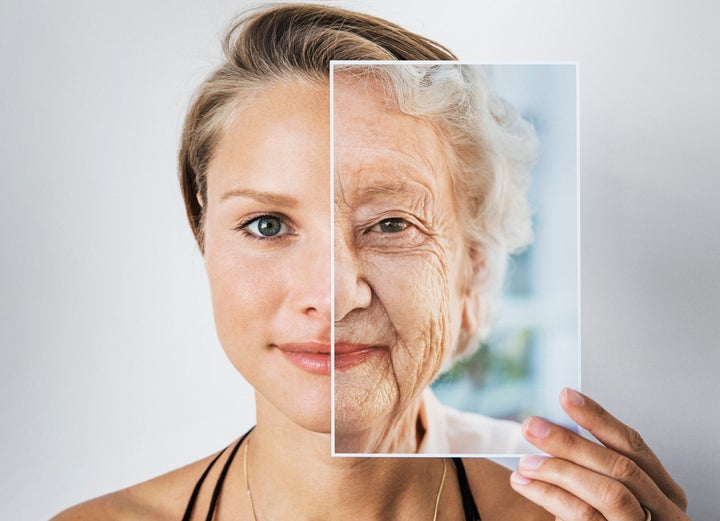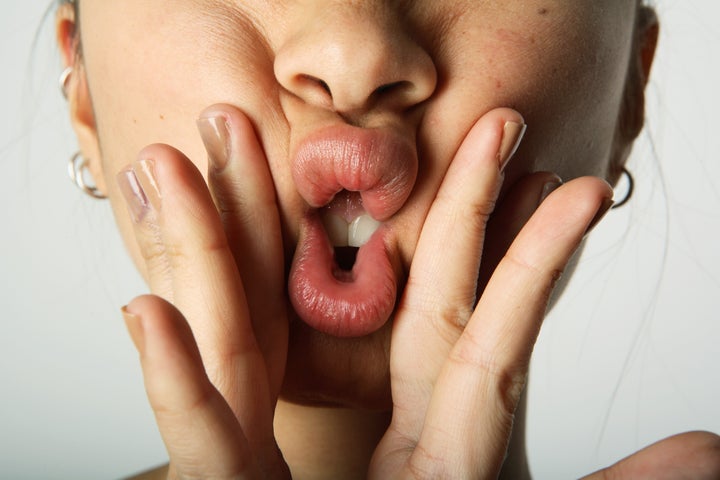
A simple search of the #faceyoga hashtag on TikTok will pull up countless videos of techniques that promise a younger- and smoother-looking face. And for once, it’s a TikTok claim that’s actually backed by some research.
But “face yoga” is so ubiquitous that you may be doubting its efficacy. Actor Gwyneth Paltrow and Goop, her lifestyle brand, have been all over it for years. You may have caught Alo Moves face yoga instructor Koko Hayashi on an episode of “Keeping Up With the Kardashians” as she taught the titular sisters a few moves.
And some skin care professionals are even giving it a whirl themselves, like Dr. Steven Line, a representative of the American Cosmetic Association. “It is something that I have been practicing over the past few years,” he told HuffPost.
As time goes by, more face yoga practitioners are popping up online, many with their own programs that you can try. For instance, Danielle Collins, aka the “Face Yoga Expert,” has a popular YouTube channel where she offers videos on how to do everything from tightening a saggy neck to bringing more symmetry to your face and plumping your lips.
So should you hop on board? Here’s all you need to know as a face yoga beginner:
Does Face Yoga Actually Work?
Currently, the verdict is mixed.
“I have seen promising results on myself, and the reasoning behind face yoga’s potential benefits is sound,” said Dr. Brooke Jeffy, a board-certified dermatologist in Arizona who combines a holistic approach with medical dermatology.
She highlighted one small study that showed some apparent benefits. Published in JAMA Dermatology in 2018, Northwestern University researchers had 16 middle-aged women perform muscle-resistant facial exercise training for 20 weeks, leading to overall improved fullness on parts of the face.
The only caveat is “that we don’t want to contract the wrong muscles,” Jeffy said, since this ”can lead to worsening of the appearance of crow’s-feet, forehead lines or frown lines.” That means doing the exercises correctly is key.
Face yoga also helps to improve the flow of blood and oxygen to your skin, which contributes to its overall health and appearance, said Dr. Lauren Penzi, a dermatologist with the practice MDCS Dermatology in New York. She noted, however, that changes will likely be minimal and “will not replace diligent sun protection, [a] skin care regimen and other cosmetic treatments.”
But Dr. Anna Guanche, a California-based dermatologist at the Bella Skin Institute practice, is not much of a fan.
“The idea of building muscle or making facial movements to improve the appearance of the face is counterintuitive,” she said. “In fact, the most popular cosmetic treatment in the country, Botox, works by inactivating muscles of facial expression, thereby reducing the repetitive pull on the skin and resulting lines and furrows.”
For instance, Guanche cited a popular face yoga exercise that involves placing your fingertip near the corner of your eye and winking your lower eyelid. But the muscle that contracts when you wink is also known to cause crow’s-feet.
“It is possibly true that face yoga may help to ease tension in the face, improve circulation and blood flow, [or] ease some neck pain,” she said. But she doesn’t see a face yoga practice doing much beyond that.

What To Pay Attention To When Doing Face Yoga
Though experts are divided on the benefits of face yoga, most agree that doing these exercises correctly is key, as improper form may lead to facial asymmetry or unwanted lines and wrinkles. Try these tips before you dive in:
Start Calm
Before beginning a session, get yourself into a calm mood.
“Take a few deep breaths to get yourself grounded in your body,” said Annelise Hagen, the founder of beauty brand Yoga Face. “Roll your shoulders a few times, roll your neck, and do some gentle stretching and breathing.” This can help you relax enough to focus on performing the exercises precisely.
Inhaling deeply, she added, brings more oxygen to the body, which assists in cell regeneration, oxygenation and calming the nervous system.
“Stress triggers ‘fight or flight,’ which in turn sets off excess adrenaline production,” Hagen said, adding that this can ”accelerate aging, drying of skin, thinning of hair and brittle nails.”
Only Move The Muscles You’re Working
While going through specific face poses, make sure that other parts of your face are not moving. “You can actually make new wrinkles when you scowl involuntarily as you concentrate,” Hagen said.
She recommended using your fingers “to neutralise areas of the face that you’re not working,” while also warning that there can be a learning curve in isolating specific muscles.
“I will always hold down the muscle areas that I don’t want to be involved in the exercise gently with my fingertips,” she said. “And I will use fingertip pressure to ... [apply] resistance where I want to build strength and volume and muscle tone.”
Keep Your Tongue In Its Proper Position
“The most important thing is your tongue posture when your face is resting,” Hayashi said, adding that the tongue is the core muscle of the face. “When the core is weak, it cannot easily stand up the face, and the face tends to sag.”
She suggested keeping your tongue up and flat on the palate whenever your face is not doing anything, so that the cheek area is slightly lifted. This can enhance your cheekbones and avoid jowls and saggy skin.
“When the cheek muscles are lifted and activated, your face gets lifted too because the upper jaw is lifted,” Hayashi said. Cheeks, she added, play a significant role in this because they are located in the middle of the face. So if you want to lift up your face, including cheeks and jowls, you want to lift up the cheek muscles — making your tongue posture critical.
“The reason why your tongue is probably down right now is that your tongue is weak, which starts as early as pre-teenagers,” she said.
Try her “tongue swing” technique to strengthen your tongue so it’s easier to keep the correct posture:
- Make a big smile.
- Show at least eight upper teeth. (Don’t expose the lower teeth.)
- Swing the tongue slowly with the upper teeth showing, and do three reps.
Be Gentle
“Facial yoga promotes repetitive facial muscle activities like frowning and smiling, which can lead to more creasing, tugging and wrinkling of the face,” said Dr. Melanie Palm, a board-certified dermatologist and cosmetic surgeon at the Art of Skin MD clinic. Other face yoga movements that require using your fingers to push or pull the skin, she said, can have a similar effect.
Thus, Palm recommended using a facial oil or serum that provides some glide to minimize unnecessary tugging. Remember to use light pressure as well.
Consistency Is Key
Hagen suggested doing a little bit of face yoga every day.
“It doesn’t take a lot, maybe five to 10 minutes,” she said. “One or two curated face poses in your trouble areas at a time. Try to be consistent, like in any other exercise program, but be gentle with yourself at the same time.”
Just like other exercise programs, it’s a longevity and consistency practice.
Start With A Clean Face
“When you practice face yoga, be mindful to keep your face and skin clean, without any makeup or heavy products,” said Rashika Khemani, a face yoga instructor with the company MyYogaTeacher.
This, she said, is because cosmetics and skin-rejuvenating products can lead to inflammation or redness, which you wouldn’t want during your exercises.
Face Yoga Exercises To Try
Want to try face yoga out for yourself? Here are some poses designed to target some of the biggest beauty complaints:
Cheek Squat
“This move is for waking up the sleeping cheek muscles to lift up the entire face,” Hayashi said.
- Say “Oh, Ah,” and make a big smile.
- Make sure your upper teeth touch the bottom lip.
- Inside the mouth, place the tongue up and flat against the palate.
- Lift up the cheeks and upper jaw with the tongue as high as possible.
- Keep the pose for 10 seconds. (Don’t use other muscles, such as the neck.)
V For Victory
This position is geared at tackling pesky crow’s feet.
- Use your fingers to make a V shape and frame your eyes with your index and middle fingers.
- Apply gentle pressure to the outer corner of your eyebrows, and slowly look up while squinting.
- Finish by closing your eyes tightly for 10 seconds.
Smiling Buddha Face
Hagen said this is a nice reset for your face that will encourage lifting in the cheek area, tone in the jaw and smoothness in the eye area.
- Practice a neutral smile in which you spread the corners of your mouth toward your ears. Keep your eyes soft so that you don’t create new wrinkles.
Kiss The Ceiling Or Lick The Ceiling
“These exercises will help tone the jaw and the neck,” Hagen said.
- Look up and pretend to “kiss the ceiling” three times in a row.
- Then look to the right, look up and kiss the ceiling three times in a row.
- Then turn the head left and look up. Kiss the ceiling three times in a row.
Here’s a variation:
- Look to your right and up, stick your tongue up toward the ceiling and take your eyes to your far right over your shoulder. Hold this for 10 seconds.
- Do the same on the left.
- Do this three times in a row.
Inner Tube
This one by Hagen is aimed at smoothing vertical lip lines.
- Inhale through the nose. Put the air underneath the upper lip to puff the lip outward, and then do the same with the lower lip.
By circulating the breath between the inside of the lips, you’ll stretch and smoother the fascia around the ring muscle of the mouth, Hagen said.
Eyelid Squat
“This move is great for lifting up eyes, [the] eyebrow and providing a more defined look,” Hayashi said.
- Keep the tongue up and flat on the palate.
- With your fingers, lift up only the lower eyelid without moving any other areas. Do this for 10 reps.